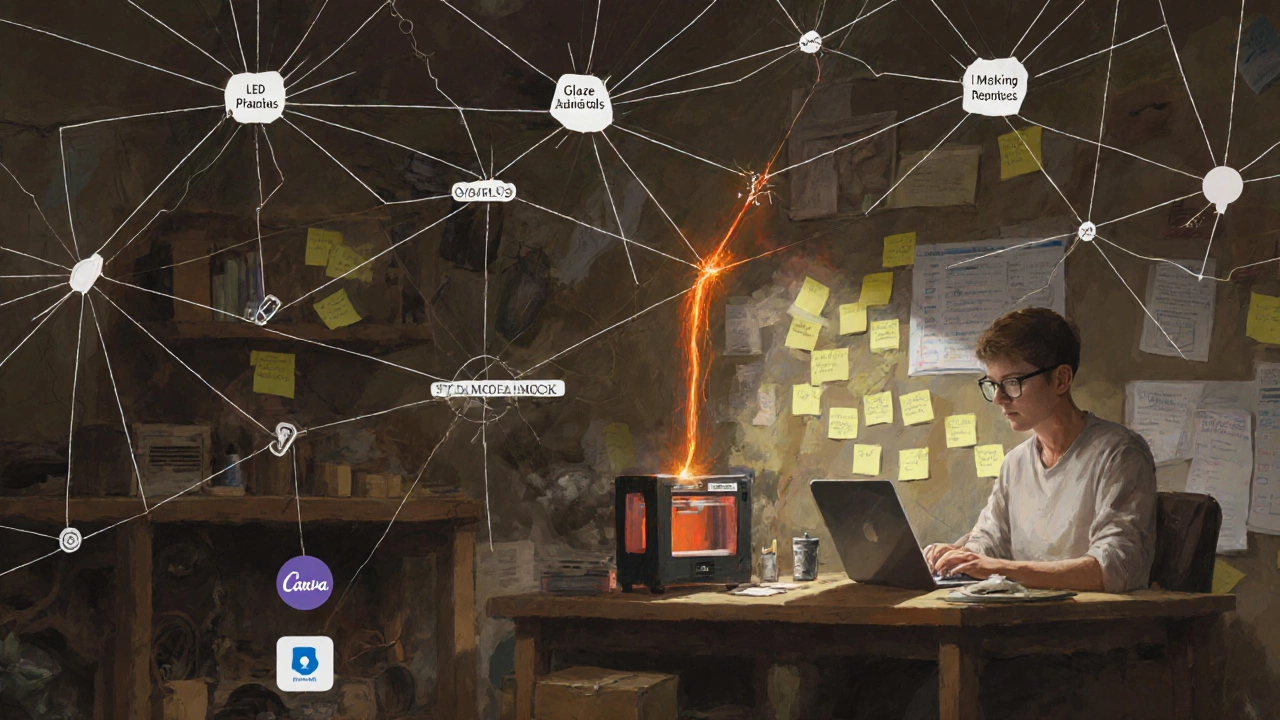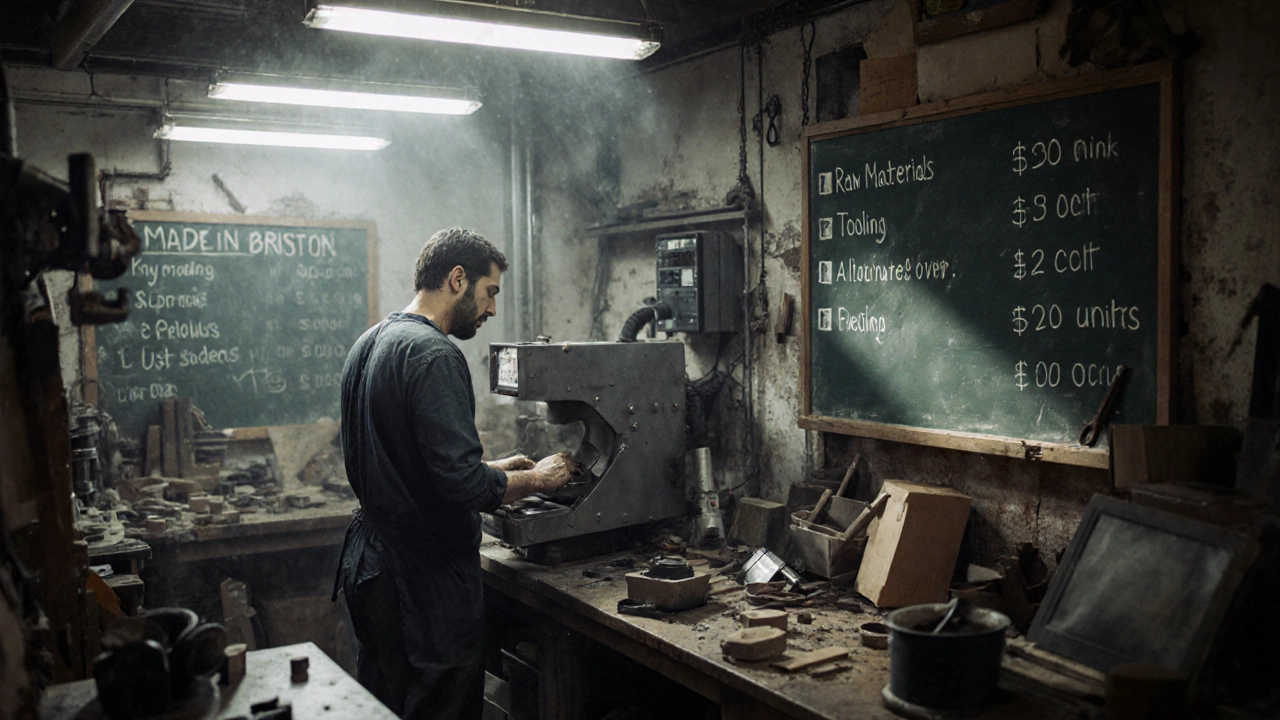Small Production Cost Calculator
Small scale production sounds simple: make a few units, sell them locally, keep costs low. But if you’ve ever tried running a small workshop, a family-run bakery, or a one-person metal fabrication shop, you know it’s not that easy. The dream of being your own boss with a lean operation often bumps into hard realities. These aren’t just minor inconveniences-they’re structural limits that can stop growth before it even starts.
High Cost Per Unit
When you produce 100 units instead of 10,000, the cost of every single item goes up. Raw materials aren’t bought in bulk, so you pay retail prices. A metal sheet that costs £200 for a 500-piece order might cost £450 for just 50 pieces. Tooling is another big hit. A custom mold for a plastic part might cost £3,000 to make. If you’re only making 200 of them, that’s £15 added to each unit just for the mold. Big manufacturers spread that cost over thousands, so their per-unit tooling cost is pennies.
Labour costs also climb. You can’t afford specialized operators for every machine. One person runs the CNC, welds the frame, packs the boxes, and answers customer emails. That’s not efficiency-it’s burnout waiting to happen. And when you’re the only one who knows how to fix the machine, downtime means lost sales.
Limited Access to Advanced Equipment
Big factories have robotic arms, automated inspection systems, and real-time quality control sensors. Small shops? They have a second-hand lathe, a hand-held caliper, and a lot of hope. Even basic automation tools like CNC routers or laser cutters cost £5,000 to £20,000. That’s more than most small producers can risk on one machine-especially when the return isn’t guaranteed.
And it’s not just about buying equipment. Maintenance and training are hidden costs. A single broken bearing on a CNC machine can shut down production for days. Finding a technician who knows your 15-year-old machine? Good luck. Most service providers only work with large clients. You end up watching YouTube tutorials at 2 a.m. while your deadline ticks away.
Inability to Compete on Price
When a customer asks for a quote, you’re up against factories in China or Poland that produce 10,000 units a week. Their per-unit cost is a fraction of yours. You can’t match their prices, and you shouldn’t try. But that doesn’t stop customers from asking. They’ll say, “I saw it online for £12,” and you’re selling yours for £35 because you’re making 50 at a time.
Here’s the truth: small scale production can’t win on price. It has to win on something else-customization, speed, quality, or story. A handmade wooden bowl might cost £45, but if it’s made in Bristol, using local oak, and comes with a note from the maker, people pay it. That’s the only way to survive. If you’re trying to be the cheapest, you’re already losing.

Supply Chain Fragility
Big companies have contracts with suppliers. They get priority shipping, bulk discounts, and backup vendors. Small producers? You’re on the bottom of the list. A delay in getting a single screw from a distributor can hold up your entire batch. And if you rely on one supplier for a key component-say, a specific type of LED or a custom gear-you’re one email away from disaster.
During the pandemic, many small manufacturers couldn’t get basic materials. Plastic pellets, copper wire, even packaging tape disappeared for months. One pottery studio in Bristol couldn’t get glaze chemicals for six months. They survived by switching to local clay and natural pigments-but that took months of trial and error.
There’s no safety net. No stockpiles. No backup logistics. One hiccup and your whole month’s output vanishes.
Limited R&D and Innovation Capacity
Big manufacturers spend millions on R&D. They test new materials, run simulations, hire engineers, and prototype dozens of versions. Small shops? They tweak one design at a time, using trial and error. If you want to test a new alloy for your brackets, you need to buy a whole spool-£800-and hope it works. No lab. No data. No team.
And innovation takes time. You can’t afford to spend three months developing a new product if you need to pay rent next week. So you stick with what sells. That’s why so many small producers end up making the same things as everyone else-because it’s safe. But safety kills growth. You end up stuck in a niche that’s shrinking, not expanding.
Marketing and Sales Challenges
Who’s handling your website, your social media, your Google Ads, your packaging design, your customer service? Probably you. Again. You’re the maker, the accountant, the delivery driver, and the marketer. And you’re not good at all of those things.
Big brands hire agencies. They run A/B tests. They track customer lifetime value. You post a photo of your product on Instagram and hope someone likes it. You don’t know your conversion rate. You don’t know which ad copy works. You don’t even know how many people visited your site last week.
And without data, you can’t improve. You’re flying blind. One month you sell 30 units. The next, you sell 8. No idea why. That’s not a business-it’s a gamble.

Scaling Is Hard-Really Hard
When you want to grow, you hit a wall. Hiring your first employee isn’t just about paying a wage. It’s about training them, buying them tools, insuring them, setting up payroll, and hoping they don’t leave after three months. Suddenly, your £1,000 monthly profit turns into £500 in losses because you’ve doubled your fixed costs.
Expanding your space? Rent goes up. More machines? More maintenance. More inventory? More storage costs and risk of waste. Many small producers hit a ceiling at 50-100 units a month-not because they can’t make more, but because the system can’t handle it. They’re stuck in a loop: too big to be a hobby, too small to be a company.
Regulatory and Compliance Burdens
Even small businesses must follow health and safety rules, environmental regulations, product safety standards, and tax laws. A food producer needs hygiene certifications. A toy maker needs CE marking. A metal fabricator needs waste disposal permits. These aren’t optional. And they’re not cheap.
For a big company, compliance is a department. For you? It’s a spreadsheet you fill out at 11 p.m. after a 14-hour day. One missed deadline, one wrong form, and you could be fined or shut down. There’s no legal team on call. You Google it. You guess. And you hope you didn’t miss something.
What Can You Do About It?
Knowing the limitations isn’t the end-it’s the start of smarter choices. Here’s what works:
- Focus on value, not volume. Charge for expertise, craftsmanship, and story-not just the object.
- Collaborate. Partner with other small makers. Share tools. Share delivery routes. Share customers.
- Use local networks. Join maker spaces, co-ops, or local business alliances. Many offer discounted equipment access and group buying power.
- Automate the boring stuff. Use free tools like Canva for graphics, Mailchimp for emails, Square for payments. Don’t waste time on things software can do.
- Know your exit. Are you building a business-or a lifestyle? If you want to sell it later, document everything. Systems matter more than passion.
Small scale production isn’t broken. It’s just different. It doesn’t need to be big to be good. But it does need to be smart.
Why can’t small scale producers compete on price with large manufacturers?
Because they don’t benefit from economies of scale. Large manufacturers buy raw materials in bulk, spread fixed costs like tooling and machinery over thousands of units, and use automated systems that reduce labour costs per item. Small producers pay higher per-unit prices for materials, handle all tasks manually, and can’t amortize setup costs across large volumes. Trying to match big brands on price leads to losses.
Is small scale production still worth it in 2025?
Yes-but only if you shift your strategy. Customers today pay more for authenticity, customization, and local impact. A handmade leather bag made in Bristol with recycled materials can command a premium over a mass-produced one from overseas. Success comes from selling value, not volume. If you focus on quality, story, and customer connection, small scale production can be sustainable and profitable.
What are the biggest hidden costs in small scale manufacturing?
Hidden costs include downtime from machine breakdowns, time spent sourcing materials, administrative work like permits and taxes, marketing without data, and the cost of errors (like ruined batches or returns). Many makers forget to charge for their own labour. If you’re working 60 hours a week and only billing for 20, you’re not making a profit-you’re subsidizing your hobby.
Can small producers use automation to overcome limitations?
Yes-but selectively. You don’t need a full robotic line. A £1,200 CNC engraver, a semi-automatic packaging machine, or a simple barcode scanner for inventory can save hours per week. The key is automating repetitive, time-consuming tasks, not everything. Start small. Track time saved. If it pays for itself in under six months, it’s worth it.
How do small manufacturers handle supply chain disruptions?
They build redundancy. Keep at least two suppliers for critical parts. Stock 2-3 weeks of essential materials. Join local buying groups to access bulk pricing. Some small makers now use 3D printing to make their own low-volume parts instead of waiting for shipments. Diversifying sources and reducing dependence on single suppliers is the new survival tactic.
What’s the most common mistake small producers make when trying to grow?
They hire too soon. Adding staff before systems are in place multiplies costs without increasing efficiency. Many small producers go from £500 profit to £1,000 loss overnight because they hired someone without a clear role or workload. Growth should be tied to consistent demand, not ambition. Scale only when you have repeat orders, not just one big sale.
Small scale production isn’t dying. It’s evolving. The makers who survive aren’t the ones who work the hardest-they’re the ones who work the smartest.
